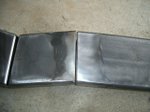Real Estate Investing 202
Digging a little deeper in Buy and Hold strategies
In Real Estate Investing 101, Part II, we covered buying and holding property for long term appreciation and wealth building. This is by no means a get rich quick scheme, but is one of the most proven ways to build wealth over time.
Finding an appropriate property
Just like with flipping, property is a required ingredient. In fact, the same sources will work for buy and hold strategies as for flipping. The primary difference is that buy and hold strategies are generally a little less stringent on cost control, as well as condition. One can be in the property for a little more money because there isn’t a short term margin to mind. REOs (bank owned property), pre-foreclosure, short sales, older homes needing updating and strong but ugly properties are still the best options.
Rental homes are more price sensitive for marketing. While a flip may be done at any price level, rentals are a bit more picky. While it certainly requires knowing the market, generally in the
Under $125k- Pro- Just as with a flip, these properties are easier to carry when they aren’t producing. Con- Even with a generous appreciation, the actual cash value will not go up as much as with more expensive properties.
$125k to $250k- Pro- This is the most active area of the market. There are more renters available, so it may be easier to keep the property occupied. Con- This is the most active area of the market. There are more properties to compete against for the renters.
$350k to $500k- Pro- These are executive rentals, and usually the renters will be more mindful of the property. There are property owners that concentrate on this market because it is quite profitable and low hassle. Con- There are higher costs to carry the property when it isn’t rented, and it may require more expenditure between renters to update the property. The renters will be pickier about amenities, fixtures and finishes.
Over $1m- Pro- The rental rate to cost is usually higher because of the rarity for SFRs. Most of these properties will be commercial, which usually have longer leases and often don’t require the landlord to make the improvements of maintain the property. Con- For the SFR market, this is a rare rental. There certainly are some out there doing well, but they will be shorter term (usually) and require more and more expensive marketing to fill. For commercial properties here in
Putting together the numbers
As with the flipping article, I have an Excel spreadsheet to examine the deal more closely. It isn’t fancy, but it does help keep all of the important points front and center so that the details don’t get in the way of the big picture.
When filling out the spreadsheet, the light gray areas are for users to input information. The light green areas have calculated values. Remember, the more accurate the input information, the more accurate your profit analysis will be.
As with flipping, it is very important to know what the upfront costs will be, both for acquisition, but also for any required renovation. However, unlike flipping, if the investor wants to reduce costs, and has the needed skills, doing more work themselves, instead of hiring contractors can be more manageable. Most investors aren’t going to have a bunch of projects running at once. If one DOES plan to have a lot of project going at one time, or if one is not appropriately skilled, hiring contractors is a better plan.
On the linked worksheet, we can see that the fictional investor purchased a property for $200k. It needed a further $25k in renovations. After renovation, the unit has an expected rental of $2250/mo. and requires about $1800/mo. to carry. I factored vacant periods in, as well as needed maintenance through the use of set-asides and reserve funds. These are included in the monthly carrying costs. I specifically expect a 90% occupancy rate. That may be a bit high, but I also tried to balance that by under shooting the expected annual increase in value.
As we delve into the numbers, what we find is that the cash flow accounts for a total of over $550k over the thirty year period. Further, the property increases in value by over $300k. This means that if the property is held the full thirty year term, the mortgage would be paid, and the investor would have collected almost $1.1m over the thirty year term, after selling the property. Even after discounting the original total investment, there is still a profit of $800k.
But, the real magic is in the leveraging. In this example, the investor fronted less than $80,000 and ended up with over $1,000,000. If one actually spends a little more for a property that doesn’t need as much renovation at the beginning, one may have a better total return.
Putting together a good team
Any good investor needs partners. These are the people one needs to have available:
Real Estate Agent- A good agent will know what is on the market. The agent should be able to help minimize the initial costs, while making sure that the property is suitable for renting, and will be readily marketable for that purpose.
Rental Agent- Knowing what a given property can rent for is valuable information. Also having someone ready to market the property as soon as practical is valuable to cut down non-productive time.
Inspector- Spending a few hundred dollars for a good inspection is money well spent. Missing a failing HVAC system or a roof issue could cost thousands. Knowing that a particular siding or electrical has shown itself to be unreliable can also be very valuable. If one can find an inspector that will give good cost estimates of repairs and upgrades that need to be performed, one may be able to cut down on the number of contractors that need to be consulted prior to buying a property. The inspector can also provide invaluable insight into the long-term viability of the expensive systems in the property.
Mortgage Loan Broker- Unless one is going to owner/occupy the properties for a number of years at the beginning of ownership, one needs to work with a mortgage broker that understands investment loans. Structuring the loan appropriately for the investor can decrease the monthly costs, and increase the cash flow of the property.
Rental Marketing Strategies
The whole point of this exercise is to get the property rented and keep it that way. There are a few things to keep in mind to maximize the long term return, and minimize risk.
Hire a good rental agent. They are part of the team. A good agent will help get the right exposure for the property, as well as make recommendations that will make the house more marketable. These are specialists. Depending on the individual agency they are with, there may be a one-time fee or they may be a monthly percentage.
Stage the property. A vacant house makes it harder for renters to mentally move in, just like buyers. A few rooms that are well staged will really increase the value in the minds of renters, so it is generally well worth the cost. This is especially true for higher end homes, but may be the thing that tips the balance for ANY property. With rentals, this may be a real standout, as few rental properties are staged.
Set rent appropriately. To get, or more likely keep, a good renter, be flexible. A good renter can cost less money between rentals. If it is a longer term renter, there will be fewer vacant periods.
Be flexible on lease/purchase possibilities. I have heard that about 1 in 8 lease purchase sales actually close. If offering a lease purchase is what it takes to get a good renter, or to keep a good renter, remain open to the possibility. It may be well worth the risk that the property may sell. Also, if the buyer/renter would like some of the rent credited to down payment, most lenders require that only an amount above market rent be applicable to down payment. Usually this money is forfeited as earnest money if the sale doesn’t close.
Research. Plan. Prepare. Remember the old adage that it takes money to make money. This holds true in buying real estate to hold as well. Targeting the money is less important than in flipping, but spending it appropriately is still important. Also, understand your own market and your own limitations.









No comments:
Post a Comment